Note: One of the challenges of this project has been dealing with a lack of appropriate terminology and notation. What I’ve come up with seems complex on the surface, so I’ll be explaining things as I go. This time around, I have a glossary of terms to help readers understand just what the heck it is that I’m talking about.
I’ve made up a lot of terminology while working on this site, and while it makes sense to me, I do not guarantee that it is entirely correct or even comprehensible to an outsider. Just so we’re all on the same page, here’s a guide to the language I use around here.
Certified Autograph Card
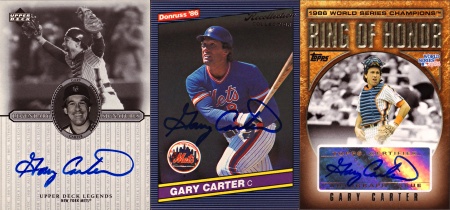
A player signature on a card or an item attached to a card bearing a certification of the signature’s authenticity. Methods for certifying authenticity vary by manufacturer. Cards that are not received from the manufacturer with a signature but are signed at a later date and are authenticated by a third party do not count as certified autograph cards; if the certification is performed by and obtained from the manufacturer in an official product release (either in a box/pack or through redemption), the card does count as a certified autograph even if the authenticity certification is on a separate document.
Chain-stitching
Style used in patches worn mainly by the Phillies, Cardinals, and Astros. Looks somewhat like miniature latch hook rugs.
Cool Base

Uniform style incorporating advanced moisture-wicking fabrics. Cool Base jerseys use a rectangular mesh base fabric with four pinhole mesh side panels (two on each side, one under the sleeve and one under it on the body). These were first used for the 2003 All-Star game and became standard across most teams over the next decade.
Or at least that was my guess. After finally breaking down and buying an authentic Cool Base Mets batting practice jersey (couldn’t resist the 25% off), I found completely different materials that were instead a match for the materials in 2011’s All-Star workout jerseys. Do the materials above have a different designation or did the Cool Base formula change? I am really out of my depth here…
Diamond Mesh
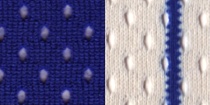
Lightweight synthetic fabric used in outer jerseys starting in the 1980s. This material can be identified by the large diamond-shaped holes in the fabric. The size and spacing of these holes varies.
Double Knit Polyester

Synthetic uniform fabric weave first used in baseball uniforms in the early 1970s due to lighter weight and superior moisture-wicking properties as compared to flannel. Double knit was better suited to coloring, which, combined with the expanding television market in the 1970s, resulted in brightly-colored uniforms typified by the famous 1975 Astros uniform.
Drop Shadow
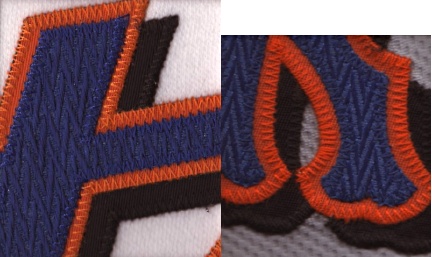
A black or otherwise dark-colored clone of text or logos that is offset from the cloned text usually down and to the right. Drop shadows were introduced in Mets uniforms when black was made an official team color in 1998 and were used on all white, gray, and pinstripe jerseys until their removal for the 2012 season. And there was much rejoicing.
Flannel

Typically cotton fabric used in baseball uniforms up until the early 1970s when uniforms switched to double knit polyester. Flannel continues to be used in some throwback jerseys. Flannel jerseys have difficulty holding coloring, with most colors fading to a dull gray. Pinstriped flannel jerseys all have the colored stripe sewn into the material with a width of six stitches (mostly pre-war) or three stitches (mostly post-war).
Game-Used Card
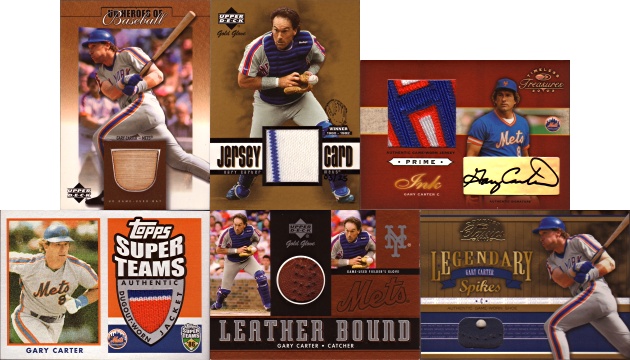
A card containing a piece of material used or worn in a game. Personal game-used items can include uniforms, bats, gloves, shoes, hats, jackets, etc. Other material such as balls, bases, outfield wall padding, on-deck circles, etc. may have been used in a game without necessarily being associated with a particular player. One of several types of cards referred to as a “relic” by Topps.
Glacier Twill
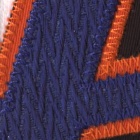
Herringbone pattern added to the top layer of multilayer Mets patches in the late 1990s. No other MLB team has adopted this style of patch. Glacier twill appears to have been removed along with drop shadows for the 2012 season.
One of One (also “1 of 1” or “1/1”)
A One of One card is any serial numbered card marked with a print run of exactly one. This is typically noted with foil stamping or hand-printed ink designating the card “1/1” or “1 of 1” (“One of One” or a zero padded variant like “01/01” is less common but still acceptable).
This term is not interchangeable with “unique,” “rare,” “one of a kind,” or any other designation that does not refer to a singular serial numbering. The terms “like a 1/1,” “eBay 1/1,” and “some would consider this a 1/1” have no meaning and should be disregarded, but not before noting that the person using these terms is an idiot and/or scumbag. The term 1/1 cannot be reached as an equivalent through division (e.g., 25/25 does not equal 1/1) nor does it refer to the first in a run of serial numbered cards (e.g., 001/100) or a card with the number of a player’s jersey (e.g., 08/25 for Gary Carter). No card without a form of serial numbering indicating a print run of exactly one can be considered a 1/1 EVER.
Patch

A non-structural uniform component attached to a uniform or other type of material by stitching for the purpose of identification of the player or team or commemoration of people, places, or events. Laundry tags, MLB Logos, and other errata, while nice to look at, do not count as patches for the purposes of this site.
Pinstripe

A regularly-spaced printed or sewn-in colored line on the outer layer of a uniform. Pinstripes are typically between 1/16 and 1/8 of an inch in width spaced approximately 1″ apart.
Piping
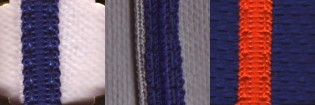
A non-structural strip of material attached to a uniform or other type of material by stitching for decorative purposes. Not considered a patch.
Pinhole Mesh

Collective term for a variety of fabrics with very small evenly spaced holes. This material is typically used for moisture-wicking purposes in areas under the arms and at the sides or as undershirts.
Rectangular Recessed Mesh (Pique)

Type of fabric weave consisting of typically rectangular depressions in the texture of the fabric. Unlike true mesh, these depressions do not go all the way through the material. The proper term is “pique,” but I didn’t find that out until it was too late to adjust my classification system. Used as the base material in Cool Base jerseys.
Relic
Generic term used by Topps to refer to a card containing game-used or manufactured materials.
Serial Numbered Card
A card with a handwritten or foil stamped number that is unique to each copy produced. To qualify as a serial numbered card, the card must indicate both the print run (typically shown as the denominator in a fraction separated by “/” or a word or number after the word “of”) and the card’s unique number in that print run. Cards with just a print run (e.g., 300 cards all marked “One of 300”) are not considered serial numbered cards.
Side Panel
Section of a jersey under the sleeves that is made from a different color and/or material from the base jersey. Side panels are common features on most modern baseball jerseys.
Recent Comments